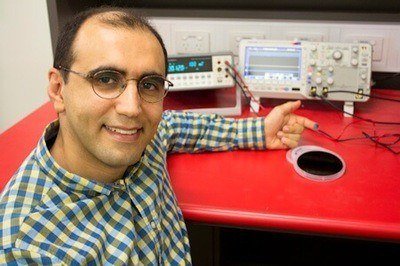Wearable Epileptic Seizure Prediction Device
Author: University of Sydney
Published: 2018/06/30 - Updated: 2019/02/08
Category Topic: Home Medical Devices - Academic Publications
Page Content: Synopsis - Introduction - Main
Synopsis: System designed to use data from non-surgical devices powered by AI and machine learning to create an affordable, portable, non-surgical device for reliable prediction of seizures for treatment-resistant epilepsy.
Introduction
Epileptic seizures strike with little warning and nearly one third of people living with epilepsy are resistant to treatment that controls these attacks. More than 65 million people worldwide are living with epilepsy.
Main Content
Now researchers at the University of Sydney have used advanced artificial intelligence and machine learning to develop a generalised method to predict when seizures will strike that will not require surgical implants.
Dr Omid Kavehei from the Faculty of Engineering and IT and the University of Sydney Nano Institute said:
"We are on track to develop an affordable, portable and non-surgical device that will give reliable prediction of seizures for people living with treatment-resistant epilepsy."

In a paper published this month in Neural Networks, Dr Kavehei and his team have proposed a generalised, patient-specific, seizure-prediction method that can alert epilepsy sufferers within 30 minutes of the likelihood of a seizure.
Dr Kavehei said there had been remarkable advances in artificial intelligence as well as micro and nano-electronics that have allowed the development of such systems.
"Just four years ago, you couldn't process sophisticated AI through small electronic chips. Now it is completely accessible. In five years, the possibilities will be enormous," Dr Kavehei said.
Study Uses 3 Data Sets from Europe and U.S.
Using that data, the team has developed a predictive algorithm with sensitivity of up to 81.4 percent and false prediction rate as low as 0.06 an hour.
"While this still leaves some uncertainty, we expect that as our access to seizure data increases, our sensitivity rates will improve," Dr Kavehei said.
Carol Ireland, chief executive of Epilepsy Action Australia, said:
"Living with constant uncertainty significantly contributes to increased anxiety in people with epilepsy and their families, never knowing when the next seizure may occur.

"Even people with well controlled epilepsy have expressed their constant concern, not knowing if or when they will experience a seizure at work, school, travelling or out with friends.
"Any progress toward reliable seizure prediction will significantly impact the quality of life and freedom of choice for people living with epilepsy."
Dr Kavehei and lead author of the study, Nhan Duy Truong, used deep machine learning and data-mining techniques to develop a dynamic analytical tool that can read a patient's electroencephalogram, or EEG, data from a wearable cap or other portable device to gather EEG data.
Wearable technology could be attached to an affordable device based on the readily available Raspberry Pi technology that could give a patient a 30-minute warning and percentage likelihood of a seizure.
An alarm would be triggered between 30 and five minutes before a seizure onset, giving patients time to find a safe place, reduce stress or initiate an intervention strategy to prevent or control the seizure.
Advantages
Dr Kavehei said an advantage of their system is that is unlikely to require regulatory approval, and could easily work with existing implanted systems or medical treatments.
The algorithm that Dr Kavehei and team have developed can generate optimised features for each patient. They do this using what is known as a 'convolutional neural network', that is highly attuned to noticing changes in brain activity based on EEG readings.
Other technologies being developed typically require surgical implants or rely on high levels of feature engineering for each patient. Such engineering requires an expert to develop optimised features for each prediction task.
An advantage of Dr Kavehei's methodology is that the system learns as brain patterns change, requiring minimum feature engineering. This allows for faster and more frequent updates of the information, giving patients maximum benefit from the seizure prediction algorithm.
The next step for the team is to apply the neural networks across much larger data sets of seizure information, improving sensitivity.
They are also planning to develop a physical prototype to test the system clinically with partners at the University of Sydney's Westmead medical campus.
Attribution/Source(s): This quality-reviewed publication was selected for publishing by the editors of Disabled World (DW) due to its relevance to the disability community. Originally authored by University of Sydney and published on 2018/06/30, this content may have been edited for style, clarity, or brevity.